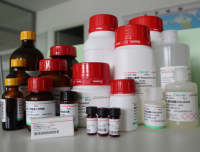Installation of Site‐Specific Methylation into Histones Using Methyl Lysine Analogs
互联网
- Abstract
- Table of Contents
- Materials
- Figures
- Literature Cited
Abstract
Chromatin structure is influenced by post?translational modifications on histones, the principal basic protein component of chromatin. In order to study one of these modifications, lysine methylation, in the context of reconstituted chromatin, this unit describes the installation of analogs of methyl lysine residues into recombinant histones. The modification site is specified by mutating the lysine of interest to cysteine. The mutant histones are expressed and purified, and the cysteine residue alkylated to produce N?methyl aminoethylcysteine, an isosteric analog of methyl lysine. Using different alkylating reagents, it is possible to install analogs of mono?, di?, or trimethyl lysine. While these analogs are not identical to methyl lysine residues, they show similar biochemical properties to their natural counterparts. The ease of synthesis of methyl lysine analog (MLA) histones, especially on a large scale, makes them particularly useful reagents for studying the effects of histone lysine methylation on chromatin structure, biophysics and biochemistry. Curr. Protoc. Mol. Biol. 90:21.18.1?21.18.10. © 2010 by John Wiley & Sons, Inc.
Keywords: methyl lysine analog; histone; methylation; methyl lysine; chromatin
Table of Contents
- Introduction
- Basic Protocol 1: Preparation of Histones for Alkylation
- Basic Protocol 2: Alkylation Reactions to Produce Methyl Lysine Analog Histones
- Reagents and Solutions
- Commentary
- Literature Cited
- Figures
Materials
Basic Protocol 1: Preparation of Histones for Alkylation
Materials
Basic Protocol 2: Alkylation Reactions to Produce Methyl Lysine Analog Histones
Materials
|
Figures
-
Figure 21.18.1 Methyl lysine analogs are made by alkylating unique cysteine residues in full‐length histones. By using different alkylating reagents, analogs can be made of (A ) trimethyl lysine, (B ) dimethyl lysine, (C ) monomethyl lysine, or (D ) unmethylated lysine. View Image
Videos
Literature Cited
| Literature Cited | |
| He, S., Bauman, D., Davis, J.S., Loyola, A., Nishioka, K., Gronlund, J.L., Reinberg, D., Meng, F., Kelleher, N., and McCafferty, D.G. 2003. Facile synthesis of site‐specifically acetylated and methylated histone proteins: Reagents for evaluation of the histone code hypothesis. Proc. Natl. Acad. Sci. U.S.A. 100:12033‐12038. | |
| Kang, T.J., Yuzawa, S., and Suga, H. 2008. Expression of histone H3 tails with combinatorial lysine modifications under the reprogrammed genetic code for the investigation on epigenetic markers. Chem. Biol. 15:1740‐1750. | |
| Kenyon, G.L. and Bruice, T.W. 1977. Novel sulfhydryl reagents. Methods Enzymol. 47:407‐430. | |
| Luger, K., Rechsteiner, T.J., Flaus, A.J., Waye, M.M., and Richmond, T.J. 1997. Characterization of nucleosome core particles containing histone protein made in bacteria. J. Mol. Biol. 272:301‐311. | |
| Luger, K., Rechsteiner, T.J., and Richmond, T.J. 1999. Preparation of nucleosome core particle from recombinant histones. Methods Enzymol. 304:3‐19. | |
| Martin, C. and Zhang, Y. 2005. The diverse functions of histone lysine methylation. Nat. Rev. Mol. Cell Biol. 6:838‐849. | |
| Shogren‐Knaak, M.A., Fry, C.J., and Peterson, C.L. 2003. A native peptide ligation strategy for deciphering nucleosomal histone modifications. J. Biol. Chem. 278:15744‐15748. | |
| Simon, M., Chu, F., Racki, L.R., de la Cruz, C.C., Burlingame, A.L., Panning, B., Narlikar, G., and Shokat, K. 2007. The site‐specific installation of methyl‐lysine analogs into recombinant histones. Cell 128:1003‐1012. |


![DKFZ-PSMA-11,4,6,12,19-Tetraazadocosane-1,3,7-tricarboxylic acid, 22-[3-[[[2-[[[5-(2-carboxyethyl)-2-hydroxyphenyl]methyl](carboxymethyl)amin](https://img1.dxycdn.com/p/s14/2025/1009/171/0405943971658126791.jpg!wh200)






